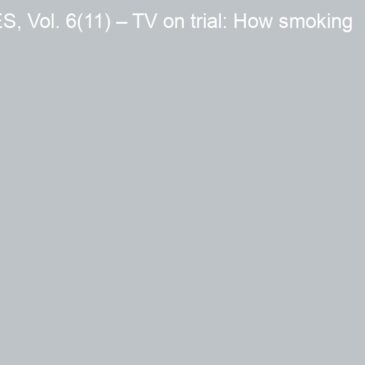Previous issues of The BASIS (e.g., The DRAM, Vol. 6(9); Addiction & the Humanities, Vol. 1(11), Vol. 6(3), and Vol. 3(2)) have discussed how exposure to smoking- and alcohol-related cues in movies and TV programs affect viewers’ smoking-related attitudes and long-term behaviors. These reviews suggest that media-related smoking cues can affect smoking behavior in a variety of ways. This week, ASHES continues this topic by presenting a randomized control study that investigated how smoking scenes in films affect immediate and short term smoking behavior (Shmueli, Prochaska, & Glantz, 2010).
Method
- The researchers randomly assigned 55 males and 45 female smokers (defined as those who smoked more than 7 cigarettes/week and brought cigarettes with them unprompted) to watch an 8 minute movie clip with or without a smoking scene. The researchers matched the movie clips in length, content, and characters, and differed only in the presence or absence of smoking behavior.
- Researchers measured:
- level of nicotine dependence, using the Fagerstrom Test for Nicotine Dependence scale (FTND: Heatherton, Kozlowski, Frecker, & Fagerström, 1991)
- level of readiness to quit smoking, using Smoking Stage of Change scale (DiClemente et al., 1991)
- impulsivity, using the Impulsation Sensation Seeking Scale (Mitchell, 2004);
- whether participants choose to smoke or not during a break that followed the movie session (i.e., self-reported measure + using a Bedfont Smokerlyzer, which indicated a change in the CO levels from baseline to after the break
- participants’ next day self-reported smoking behavior during the 30 minutes after the study end.
- The researchers used logistic regression to identify factors that increase likelihood to smoke.
Result
- There was agreement between self-reported measure of smoking behavior during the break and the change in the CO level (k = .98, p < .001).
- Table 1 presents the percent of participants who smoked during the break and within 30 minutes after the end of the study and the odd ratios resulting from the logistic regression (p <.05). The odd ratios show that participants who watched the smoking scene were 3 times more likely to smoke during the break and within 30 minutes after the study than those who watched the smoke-free scene.
- The logistic regression also showed that the level of nicotine dependency, high impulsivity and lower readiness to quit smoking all increased the odds to smoke (p < .05) during the break and 30 minutes after the end of the study
| Film clip | Odd ratio
(95% CI) |
||
| Smoking N = 50 | No smoking
N = 50 |
||
| During the break | 32 (64%) | 22 (44%) | 3.06 (1.01, 9.29) |
| Within 30 minutes after the study end | 25 (63%) | 15 (38%) | 3.64 (1.17, 11.30) |
Figure. Smoking after watching the smoking vs. non-smoking film clips.
Limitations
- The sample consisted of relatively light smokers only (average FTND = 2.6)*.
- Experimental settings create an artificial environment that might limit the generalizability of the study. For example, exposure to a brief smoking scene might influence the viewers more than seeing the same scene as a part of a full-length movie.
Conclusion
Previous studies have demonstrated relationships between watching smoking or alcohol–related cues in movies and commercials and long-term (i.e., several years after baseline) smoking and drinking attitudes and behavior (Dalton et al., 2003; Stacy, Zogg, Unger, & Dent, 2004). In this BASIS we report on the first controlled experiment to investigate the immediate effect of smoking scenes on smoking behavior. The major result of the study is that exposure to smoking scenes increases the likelihood of immediate smoking behavior. This finding implies that those who would like to quit smoking should avoid watching movies with smoking context. Future studies should investigate more factors that increase or decrease the effect of smoking-related cues on immediate smoking behavior, such as identification with a smoking protagonist or length and vividness of the movie. In addition, future studies investigate the relationship between immediate gratification of smoking urges and long-term outcomes.
-Julia Braverman
References
Dalton, M. A., Sargent, J. D., Beach, M. L., Titus-Ernstoff, L., Gibson, J. J., Aherns, M. B., et al. (2003). Effect of viewing smoking in movies on adolescent smoking initiation: A cohort study. The Lancet, 362(9380), 281-285.
DiClemente, C. C., Prochaska, J. O., Fairhurst, S. K., Velicer, W. F., Velasquez, M. M., & Rossi, J. S. (1991). The process of smoking cessation: An analysis of precontemplation, contemplation, and preparation stages of change. Journal of Consulting and Clinical Psychology, 59(2), 295-304.
Heatherton, T. F., Kozlowski, L. T., Frecker, R. C., & Fagerström, K.-O. (1991). The Fagerström Test for Nicotine Dependence: A revision of the Fagerström Tolerance Questionnaire. British Journal of Addiction, 86(9), 1119-1127.
Mitchell, S. H. (2004). Measuring Impulsivity and Modeling Its Association With Cigarette Smoking. Behavioral and Cognitive Neuroscience Reviews, 3(4), 261-275.
Shmueli, D., Prochaska, J. J., & Glantz, S. A. (2010). Effect of Smoking Scenes in Films on Immediate Smoking: A Randomized Controlled Study. American Journal of Preventive Medicine, 38(4), 351-358.
Stacy, A. W., Zogg, J. B., Unger, J. B., & Dent, C. W. (2004). Exposure to Televised Alcohol Ads and Subsequent Adolescent Alcohol Use. American Journal of Health Behavior, 28(6), 498-509.
What do you think? Please use the comment link below to provide feedback on this article.
_____________
* A score of 5 or more indicates a significant dependence, while a score of 4 or less shows a low to moderate dependence.




